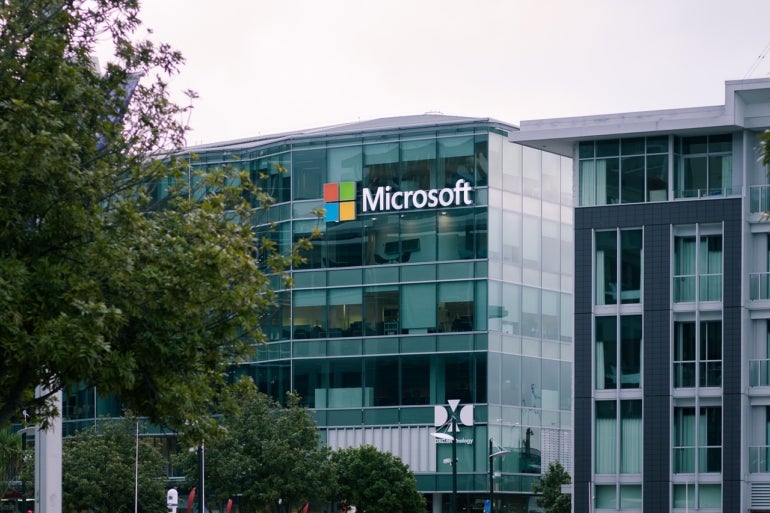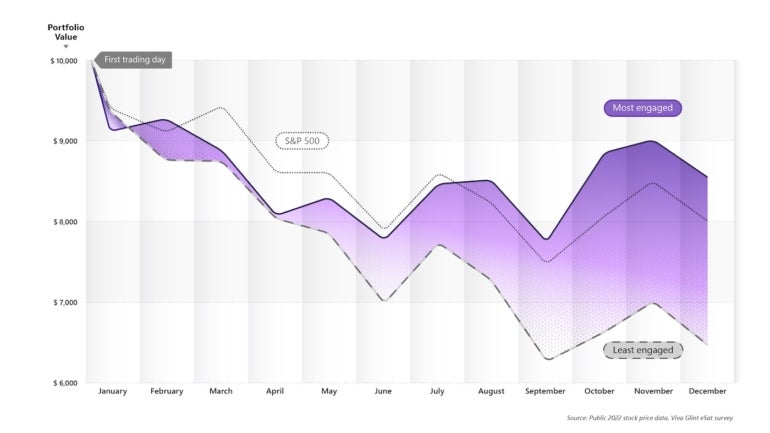Microsoft’s Work Trend Index: Employee engagement pays off in productivity, stock price
This new Microsoft research report details the benefits of using a feedback flywheel to keep employees engaged.

Microsoft’s latest Work Trend Index report aims to quantify how employee engagement affects business outcomes. The results of Microsoft’s research are clear: The most engaged organizations outperformed the S&P index, while the least engaged lagged behind it.
2022 wasn’t a good year for the stock market, as the economy was slow to improve while pandemic restrictions were lifted, but those companies that worked to engage with their employees were twice as successful as those that didn’t. The Microsoft report details one way to engage with employees: through a feedback flywheel.
Jump to:
How does the survey define employee engagement?
Microsoft’s research defines employee engagement as “the extent to which employees are empowered, energized, and invested to contribute to organizational success.”
It’s a useful definition, as it’s one that can be tracked using tools like Viva and Glint, along with the various language understanding tools in Azure Cognitive Services, which can easily extract sentiment trends from natural language freeform responses to surveys.
What makes employees engaged?
Microsoft’s Work Trend Index report suggests employees are engaged by clear communication and well-defined goals, where everyone in the organization knows what they are doing and why, as well as how to make changes and handle suggestions when necessary. It’s not a matter of management coming in, providing goals and then going away; an engaged workforce requires continuous interaction. That demand for continuous interaction leads to one of the more interesting concepts in Microsoft’s report: the idea of the feedback flywheel.
What is a feedback flywheel?
A feedback flywheel is a way of using feedback loops to keep employees and management in a continuous communication process, bringing in signals from across the organization to understand more than a handful of employee requests and comments. Traditional feedback systems don’t work with live data, so they don’t have access to assets and tools like employee sentiment or collaboration data.
By mixing traditional feedback tools with these new data sources, it’s now possible for organizations to see how employees respond to new programs, measuring overall engagement. By working to understand whether staff members are happy with management actions, leadership teams can fine-tune their responses to help employees know their concerns have been heard and acted upon. The effects can be considerable: A 40% increase in confidence in feedback systems is only the start, with employees 56% more likely to say processes improve as a result of their comments.
Feedback flywheels don’t need to be organization-wide. The tools built into platforms like Microsoft Viva can work more granularly, allowing individual managers to set up monitoring for their own teams. The underlying AI-based analysis tooling can be trained on more specific data, producing team-level metrics.
But there’s still the need to put the right processes in place around your feedback tools. It’s all well and good to build a feedback monitoring system, but it won’t have any value if your staff doesn’t know their feedback is being turned into real action. You need to have transparency, giving visibility into how you process feedback; make sure employees know they are part of the process and their feedback does make tangible changes.
Why should C-level execs care about employee engagement?
Research like this is useful because it helps organizations benchmark themselves against their peers, helping codify best practices and providing the metrics necessary to measure results. By tying those metrics directly to financial results, Microsoft is pointing out the importance of an engaged workforce to more than middle management and HR departments — an engaged workforce is something that should also be important to C-level executives and leaders who need their teams to deliver the productivity that’s key to company finances and growth.
Survey methodology
Microsoft’s latest Work Trend Index compared employee survey responses across more than 3 million employees, 226 companies (and their stock prices) and 17 industries for the whole of 2022. The results were compared to the overall performance of the S&P 500, showing how employee engagement affected company value (Figure A).
Figure A

Microsoft’s Viva Glint tools were used to analyze employee surveys, looking for positive sentiment across several areas. It was primarily used as a tracker for engaged employees, as unengaged employees are likely to have a low sentiment for their employer. The resulting data was grouped to show the workforces with the lowest and highest engagement, compared with the return on the company stock price.
For all the latest Technology News Click Here
For the latest news and updates, follow us on Google News.
